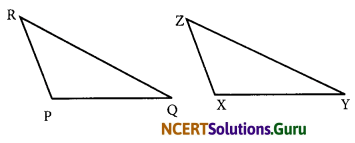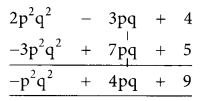NCERT Solutions for Class 7 Maths Chapter 8 Comparing Quantities Ex 8.3
These NCERT Solutions for Class 7 Maths Chapter 8 Comparing Quantities Ex 8.3 Questions and Answers are prepared by our highly skilled subject experts.
NCERT Solutions for Class 7 Maths Chapter 8 Comparing Quantities Exercise 8.3
Question 1.
Tell what is the profit or loss in the following transactions. Also find profit per cent or loss per cent ¡n each case,
(a) Gardening shears bought for 250 and sold for ₹ 325 .
(b) A refrigerator bought for ₹ 12,000 and sold at 13,500.
(c) A cupboard bought for ₹ 2,500 and sold at 3,000.
(d) A skirt bought for ₹ 250 and sold at ₹ 150.
Answer:
(a) Cost Price (CP) = ₹ 250
Selling Price = ₹ 325
Profit = S.P – C.P
= ₹ 325 – 250
= ₹ 75
Profit% = \(\frac{75}{250}\) x 100%
= 3 x 100%
= 30%
Profit = ₹ 75; Profit % = 30%.
![]()
(b) Cost Price (CP) = ₹ 12,000
Selling Price (SP) = ₹ 13,500
Profit = SP – CP
= ₹ 13500 – ₹ 12000
= ₹ 1500
Profit% = \(\frac{\text { Profit }}{\text { C.P. }}\) x 100
= \(\frac{1500}{12000} \times\) x 100%
= \(\frac{150}{12} \%\)
= 12.5%
Profit = ₹ 1500 and Profit% = 12.5%.
(c) Cost Price (CP) = ₹ 2500
Selling Price (SP) = ₹ 3000
Profit = SP – CP
= ₹ 3000 – 2500
= ₹ 500
Profit% = \(\frac{\text { Profit }}{\text { C.P. }}\) x 100
= \(\frac{500}{2500}\)
= \(\frac{5}{25}\) x 100
= 5 x 4 = 20%
Profit = ₹ 500
and Profit% = 20%.
(d) Cost Price (CP) = ₹ 250
Selling Price (SP) = ₹ 150
Loss = CP – S.P
= ₹ 250 – 150
= ₹ 1oo
Loss% = \(\begin{aligned}
&\text { Loss } \\
&\hline \text { C.P. }
\end{aligned}\) x 100
= ₹ \(\frac{100}{250}\) x 100%
= \(\frac{10}{25}\) x 100%
= 10 x 4 = 40%
Loss = ₹ 100; loss% = 40%.
![]()
Question 2.
Convert each part of the ratio to percentage:
(a) 3 : 1
(b) 2 : 3 :5
(c) 1 : 4
(d) 1 : 2 : 5
Answer:
(a) 3:1
Total parts of the ratio = 3 + 1 = 4
Percentage of the first part
= \(\frac { 3 }{ 4 }\) x 100% = 3 x 25% = 75%
Percentage of the second part
= \(\frac { 1 }{ 4 }\) x 100 = 25%
(b) 2:3:5
Total parts of the ratio
= 2 + 3 + 5 = 10
Percentage of the first part
= \(\frac { 2 }{ 10 }\) x 100%
= 2 x 10% = 20%
Percentage of the second part
= \(\frac { 3 }{ 10 }\) x 100% = 3 x 10% = 30%
Percentage of the third part
= \(\frac { 5 }{ 10 }\) x 100% = 5 x 10% = 50%
1st part = 20%, 2nd part = 30%; 3rd part = 50%
(c) 1:4
Total parts of the ratio = 1+4 = 5
Percentage of the first part
= \(\frac { 1 }{ 5 }\) x 100% = 20%
Percentage of the second part
= \(\frac { 4 }{ 5 }\) x 100% = 80%
Percentage of first part = 20%
Percentage of second part = 80%
![]()
(d) 1:2:5
Total parts of the ratio = 1 + 2 + 5 = 8
Percentage of the first part
= \(\frac { 1 }{ 8 }\) x 100% = \(\frac { 25 }{ 2 }\)% = 12\(\frac { 1 }{ 2 }\) % or 12.5%
Percentage of the second part
= \(\frac { 2 }{ 8 }\) x 100% = 25%
Percentage of the third part
= \(\frac { 5 }{ 8 }\) x 100% = \(\frac { 125 }{ 2 }\) %
= 62\(\frac { 1 }{ 2 }\)% or 62.5%
Percentage of the first part = 12\(\frac { 1 }{ 2 }\) %
Percentage of the second part = 25%
Percentage of the third part = 62\(\frac { 1 }{ 2 }\) %
= \(\frac { 2 }{ 35 }\) x 100%
= \(\frac{2 \times 20}{7} \%=\frac{40}{7} \%=5 \frac{5}{7} \%\)
Increase percentage = 5\(\frac{5}{7}\)
Question 3.
The population of a city decreased from 25,000 to 24,500. Find the percentage decrease.
Answer:
Initial population = 25000.
Decreased population = 24500
Decrease in population = 25000 – 24500 = 500
Percentage of decrease = \(\frac{\text { Decrease in population }}{\text { Initial population }}\) x 100
= \(\frac{500}{25000}\) x 100% = \(\frac{50 \times 1}{25}\) = 2%
Question 4.
Arun bought a car for ₹ 3,50,000. The next year, the price went upto ₹ 3,70,000. What was the percentage of price increase?
Answer:
Initial cost = ₹ 3,50,000
Increased cost = ₹ 3,70,000
Increase in price = ₹ 3,70,000 – 3,50,000
= ₹ 20,000
Increase% = \(\frac{\text { Increase in amount }}{\text { Initial cost }}\) x 100
= \(\frac{20,000}{3,50,000}\) x 100%
= \(\frac{2}{35}\) x 100%
= \(\frac{2 \times 20}{7} \%=\frac{40}{7} \%=5 \frac{5}{7} \%\)
Increase percentage = 5\(\frac{5}{7} \%\)
![]()
Question 5.
I buy a T.V. for ₹ 10,000 and sell it at a profit of 20%. How much money do I get for it?
Answer:
Cost price of the T.V = ₹ 10,000
Profit = 20% of C.P = \(\frac{20}{100}\) x 10,000
= \(\frac { 1 }{ 5 }\) x 10000 = ₹ 2000 5
Selling price of the T.V = ₹ 10,000 + ₹ 2000 = ₹ 12,000
Hence, I get ₹ 12,000
Question 6.
Juhi sells a washing machine for ₹ 13,500. She loses 20% in the bargain. What was the price at which she bought it?
Answer:
Let the cost price of the washing machine be Y
Selling price of the washing machine = ₹ 13,500
Loss = 20% of C.P 20
= \(\frac{20}{100}\) x x
= \(\frac{1}{5}\) x x = \(\frac{x}{5}\)
Selling price = Cost price – Loss
13500 = x – \(\frac{x}{5}\)
= \(\frac{5 x-x}{5}=\frac{4 x}{5}\)
\(\frac{4 \mathrm{x}}{5}\) = 13500
x = \(\frac{13500 \times 5}{4}\)
= ₹ 3,375 x 5 = ₹ 16,875
She bought it for ₹ 16,875.
Question 7.
(i) Chalk contains calcium, carbon and oxygen in the ratio 10 : 3 : 12. Find the percentage of carbon in chalk.
(ii) If in a stick of chalk, carbon is 3 g, what is the weight of the chalk stick?
Answer:
(i) The ratio of calcium : carbon :
oxygen = 10 : 3 : 12
Total ratios = 10 + 3 + 12 = 25
Percentage of carbon in chalk
= \(\frac { 3 }{ 25 }\) x 100% = 3 x 4% = 12%
(ii) Let the weight of the stick of chalk be ‘x’ g
12% of the chalk mixture is carbon 12% of x = 3
\(\frac{12}{100}\) x x = 3
x = \(\frac{3 \times 100}{12}=\frac{100}{4}\) = 25g
Weight of the chalk stick = 25 g
![]()
Question 8.
Amina buys a book for ₹ 275 and sells it at a loss of 15%. How much does she sell it for?
Answer:
Cost price of the book = ₹ 275
Loss = 15% of C.P
S.P of the book = ₹ 275 – ₹ 41.25
= \(\frac{15}{100}\) x 275 = ₹ 233.75
= ₹ \(\frac{15}{4}\) x 11
S.P of the book = ₹ 233.75
= ₹ 41.25
Question 9.
Find the amount to be paid at the end of 3 years in each case:
(a) Principal = ₹ 1200 at 12% p.a.
(b) Principal = ₹ 7500 at 5% p.a.
Answer:
(a) Principal (P) = ₹ 1200
Rate (R) = 12%
Time (T) = 3 years
T ,T. P x R x T
Interest (I) = \(\frac{\mathrm{P} \times \mathrm{R} \times \mathrm{T}}{100}\)
= ₹ \(\frac{1200 \times 12 \times 3}{100}\)
= ₹ 12 x 12 x 3
= ₹ 432
Amount = Principal + Interest
= ₹ 1200 + 432
= ₹ 1632
Amount to be paid at the end of 3 years = ₹ 1632
![]()
(b) Principal (P) = ₹ 7500
Rate (R) = 5% p.a.
Time (T) = 3 years
Interest = \(\frac{\mathrm{P} \times \mathrm{R} \times \mathrm{T}}{100}\)
= ₹ \(\frac{7500 \times 5 \times 3}{100}\)
= ₹ 75 x 5 x 3
= ₹ 1125
Amount= Principal + Interest
= ₹ 7500+ ₹ 1125 = ₹ 8625
Amount to be paid = ₹ 8625
Question 10.
What rate gives ₹ 280 as interest on a sum of ₹ 56,000 is 2 years?
Answer:
Principal (P) = ₹ 56000
280 = 560 x R x 2
Rate (R) = R
R = \(\frac{280}{560 \times 2}\) %
Time (T) = 2 years
Interest (I) = ₹ 280
R = \(\frac{1}{2 \times 2} \%=\frac{1}{4} \%\)
or 0.25%
Interest (I) = \(\frac{\mathrm{P} \times \mathrm{R} \times \mathrm{T}}{100}\)
Thus, rate of interest = \(\frac{1}{4}\) % or 0.25%
280 = \(\frac{56000 \times \mathrm{R} \times 2}{100}\)
Question 11.
If Meena gives an interest of ₹ 45 for one year at 9% rate p.a. What is the sum she has borrowed?
Answer:
Let Principal be ‘P’
Rate (R) = 9% p.a.
45 = \(\frac{\mathrm{P} \times 9 \times 1}{100}\)
Interest (I) = ₹ 45
P x 9 = 45 x 100
Time (T) = 1 year
P = \(\frac{45 \times 100}{9}\)
Simple interest = \(\frac{\mathrm{P} \times \mathrm{R} \times \mathrm{T}}{100}\)
= ₹ 500
The sum borrowed is ₹ 500
NCERT Solutions for Class 7 Maths Chapter 8 Comparing Quantities Ex 8.3 Read More »

























